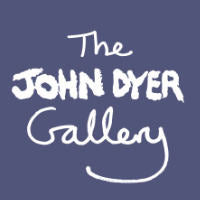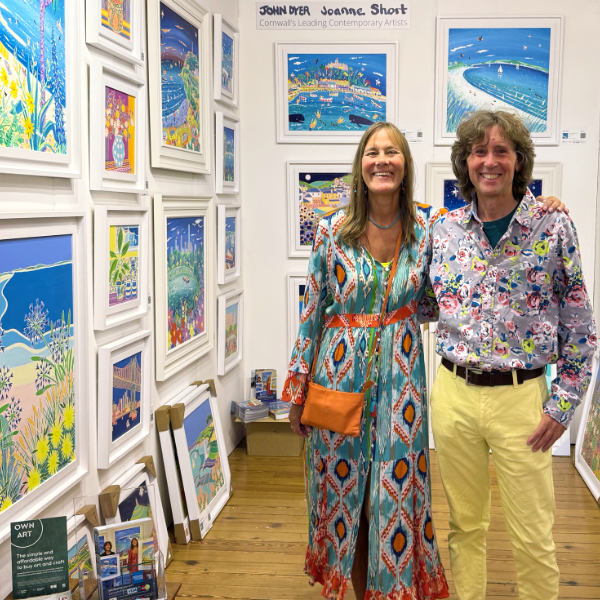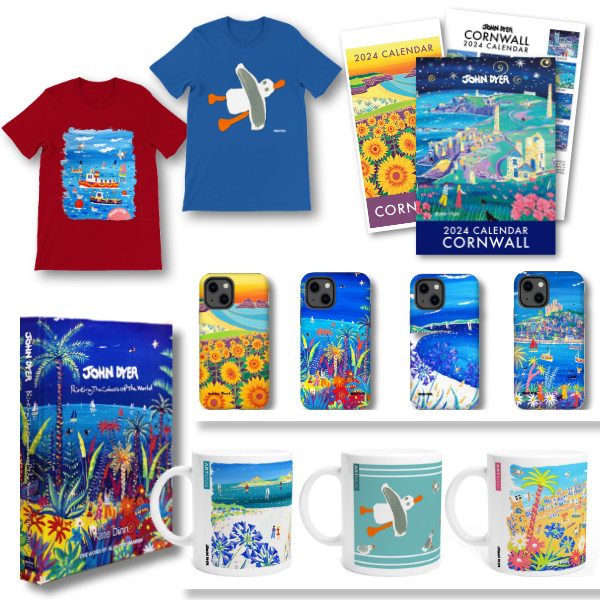Christmas Catalogue Exhibition Paintings Now Available | Private View December 6th in St Ives!
Christmas Catalogue Exhibition Paintings Now Available | Private View December 6th in St Ives!
Invest in British Art from Cornwall's Leading Artists | Free Worldwide Delivery
JOHN DYER
Original Paintings
New paintings available to buy online now by Cornwall's best loved artist.
JOANNE SHORT
Original Oil Paintings
New paintings available to buy online now by Cornwall's acclaimed colourist painter.
TED DYER
Original Oil Paintings
New paintings available to buy online by Cornwall's best known impressionist artist.
All Original Paintings
View all of the new original paintings that we have available to buy online now in our online gallery.
The ones you missed
View all of the recently sold original paintings by our Cornish artists John Dyer, Ted Dyer and Joanne Short.
Cornwall Art Prints
Museum-quality prints. Framed, Unframed, Signed & Wall Art Posters
Christmas Exhibition St Ives 2024
Private View: 6th December 6pm to 8pm
Exhibition continues: 7th - 8th
Summer Collection 2024
Online exhibition of new paintings by John Dyer & Joanne Short.
Easter Exhibition St Ives 2024
New paintings by John Dyer & Joanne Short in the historic Porthmeor Studios in St Ives.
Explore our Previous Exhibitions
Enjoy exploring our previous exhibitions and discover amazing paintings.
Art Collectors Club.
Enjoy 5% off your first order, regular offers, exclusive exhibition invitations and artist and gallery updates in our monthly email newsletter.
In 1989 John Dyer was awarded a Travelling Bursary from Thames Television in London to enable him to explore the Amazon Rainforest in Brazil.
"The experience of seeing the plant life of the rainforest gave him a fascination with ethno-botany and biodiversity which has lasted ever since."

The catalyst came at the end of his second year with the award of a travelling bursary by Thames TV. John has given a disarming account of how this came about. Despite his rebellious tendencies, he was recognised as one of the top students in his year and therefore was put on a short list of nominations for the award by his college. On his way to the interview with his portfolio, without knowing what to expect, he happened to bump into a fellow nominee from his polytechnic who was just returning from the interview and who alerted him to the fact that he needed to have a clear idea of how and where the bursary would be used. By the time he got off the Tube, John had his plan worked out and he told the interviewers that he wanted to travel to the Brazilian rainforest to make a photographic study both of areas of destruction and (even more importantly for John) of its remaining natural beauty, using black and white infrared film. Thames TV agreed with him that this was the ‘perfect medium’ and an admirable way of putting the funding to good use, and offered him the bursary on the spot.
While John’s preparation for the interview had been somewhat haphazard, his preparation for the trip itself was anything but. Preferring the idea of being accompanied, he invited a friend from his Foundation year in Falmouth to go with him and apply for his own funding to carry out a separate creative project. Tim Varlow was, like John, about to start the final year of his degree but at nearby St Martin’s School of Art, where he was studying Audio-Visual Graphic Design. The £800 bursary would barely cover their travel expenses and leave nothing at all for photographic and other equipment, so the two set about raising sponsorship. Within five months, John and Tim succeeded in attracting an impressive £10,000’s worth of money and equipment, largely through a mixture of sheer hard work, persistence and a huge number of persuasive letters: film cameras were donated by Television South West (forerunner of ITV West Country) and sound recording equipment by BBC Radio Cornwall; cameras and film from Keith Johnson and Pelling, Kodak and Ilford; special lightweight tropical clothing from Rohan and sunglasses from Style Eyes, in return for advertising photography; and financial support was received from a variety of corporate sponsors, including Volvo, English China Clays and Sedley Place Graphics, and from charitable and philanthropic groups including Rotary International, CAFOD (Christian Aid For Overseas Development) and The David Shepherd Trust. Much of the support they received was reciprocal: during the three-week trip, they undertook to produce material for three magazine articles, social documentary and advertising photography, a three-minute film and a radio programme. A key requirement of John’s acceptance of the Thames TV bursary was his agreement to exhibit the infrared photographs he would take of the Amazon rainforest at the television company’s headquarters after his return.

One especially helpful contact was with the Royal Geographical Society, through the explorer and writer Robin Hanbury-Tenison, to whom John wrote outlining the project. Robin – who would reunite with John more than 25 years later when they worked together to realise the joint Eden Project/Survival International initiative ‘Spirit of the Rainforest’ – proposed John as a Fellow of the Royal Geographical Society, which opened many doors for him to gain access to expeditionary advisory services, and gave him credibility when applying for sponsorship. Robin also invited John to meet him at the RGS where by a happy coincidence, six weeks before their departure, a major conference on the Maracá Rainforest Project was taking place, organised jointly with the Instituto Nacional Pesquisas da Amazônia (National Institute of Amazonian Research). This brought about an introduction to the scientists of the Ducke Forest Reserve, a major research site for the study of Amazonian flora and biodiversity near Manaus in the western Amazon, which formed the starting point of their expedition. A letter to the Geographical Magazine, also suggested by Robin, produced a fluent Portuguese speaker to act as their translator, who greatly facilitated their interaction with the people of the Amazon region. Without Nanda, John says, ‘we wouldn’t have been able to understand their culture. Everyone was so interested in us and came up to us in the street and invited us to their houses and we were able to discuss their political system and culture with them.’ These encounters also gave John an insight into the lives of those struggling to survive in small settlements in and around the jungle and a more nuanced approach to the many issues affecting the rainforests.
"Travelling in the Amazon in 1989 was incredible, I spent three weeks exploring and photographing many parts of the Amazon river and its tributaries, spent time with WWF scientists, saw floating hospitals, met local people in very remote regions of the Rio Negro and photographed and recorded the natural beauty of this spectacular cathedral of nature. Photography however could not satisfy me as it simply recorded what I could see and as powerful medium as photography is it just couldn't capture the energy, colour, spirit, emotion and feeling of being in the rainforest. From that moment on I have painted, as painting comes from one's heart and soul and transcends time itself."
John Dyer. FRGS
During the course of their 17,000-mile round trip in November and December 1989, John, Tim and Nanda travelled into very remote areas and encountered numerous hazards, both natural and man-made. For about a week, as they travelled by boat up the Rio Negro (a tributary of the Amazon north-west of Manaus), lit only by starlight at night, they were out of contact with the outside world – something which is hard to imagine now when almost everywhere on the planet is connected by the internet and mobile phones. In the Ducke Reserve, where they spent three days, sleeping out in the open in hammocks and going on night hikes to record the soundtrack, they had to follow literally in their guides’ footsteps because of the constant danger of snakes. Poisonous spiders, aggressive bees and flying ants were also an ever-present threat. John had a gun pointed at his head at the airport; they had their first car accident within hours of arriving in Rio de Janeiro, and another on the last leg of their journey when the front wheel of the jeep in which they were travelling came off, after which they continued their journey by hitchhiking. None of them returned unscathed: John had a wound on his foot which nearly turned gangrenous; Nanda fell off a rickety gangplank and needed physiotherapy for weeks, as well as returning with malaria; and they all suffered badly from dehydration and dramatic weight loss – but John and Tim both said that they would do it again!
Explore our main art collections to find perfect original paintings, limited edition signed prints, open-edition prints, wall art prints and posters & artist designed gifts.
N.B. If you don’t see your confirmation email shortly, please check your spam or junk folder.
We love John’s pictures of France. We already have an original of Nice but bought this poster as it brings back so many wonderful memories.
Superb communication and attentiveness from gallery. The poster is of course wonderful.
Love this print - bright, sunny and makes one feel warm and happy!
Delivery was all easy and straightforward. Many thanks.
The print is even better in real life. It’s printed on beautiful quality paper which makes the colours really pop and the painting itself is simply charming. It brings so much joy to us. We love it! Thank you
A lovely art print bought as a memory of our holidays on the beautiful Isles of Scilly.
The frame is very well made and displays the art print beautifully. Ordering from John Dyer Gallery was simple and delivery swift. I would not hesitate to order from them again.
Thank you so much for the amazing customer service, and most beautiful painting of our favourite place
Absolutely beautiful painting. So thrilled with it. Completely amazing service: beautifully packaged, framed and safely delivered really quickly.
Lovely picture, bought 3 after our recent trip to Cornwall. Already thinking of getting more.
Have walked this coastal path from St Agnes to Chapel Porth and back countless time. I am now pleased that this fabulous print is the first thing I see every morning. Beautiful, happy colours. Nice frame. I’m now planning of ordering one of Mount’s Bay by same artist.
Such a vibrant, pretty piece. I visited Fowey Harbour recently and was looking for a small keepsake to have with me back in the U.S. Shipping abroad was seamless and I received this item quite quickly. I've had many compliments since putting this on my phone and am happy to be reminded of a wonderful trip to a magical place this summer.
As always professional , efficient and prompt .
We have been coming here for 27 years together. This is our place especially during lockdown. John has captured our place beautifully. I have many of John’s prints, always in my birthday, so this one for June is 😍 perfect. They always make me smile, colourful, fun and look perfect in our home
I found the whole experience flowed from start to finish. The customer service was exceptional, they couldn’t do enough for me. This is the kind of first rate service I would expect from such a professional artist. Thank you.
Lovely,bright and colourful ready to hang.
Bought back lovely memories.
Posted promptly too.
Thank you.
I have loved John Dyers work for many years. I have some prints at home and at work.
Gorgeous, vibrant colours. Reminds me of many happy evenings at the Minack when growing up in Cornwall. Special memories.
great service. Thank you.
I purchased “Bathing Belles” to add to 2 other John Dyer original paintings collected over the years .
We decorated our house and removed another trio of prints , so were hoping to find something suitable at John’s latest exhibition.
We were not disappointed . The colours are vivid and the painting has elements of my childhood : a trip on the Enterprise boat , snd swimming in the sea . There is also a signature seagull (oh how I love those seagulls !!) a chough , a puffin and a friendly seal . I like the play on the words in the title, with bluebells in the foreground .
The off white frames complement the colour palette perfectly .
I was extremely impressed on how quickly the painting was delivered after the exhibition - I had expected to wait at least a couple of weeks , but within days it was with me . As always it was packaged very carefully .




